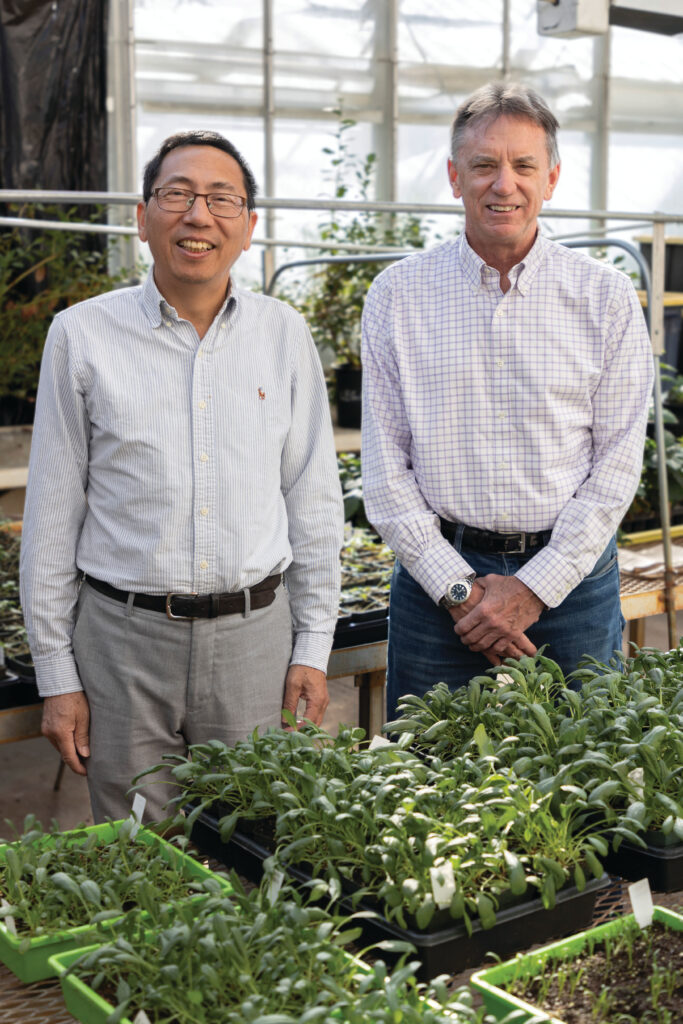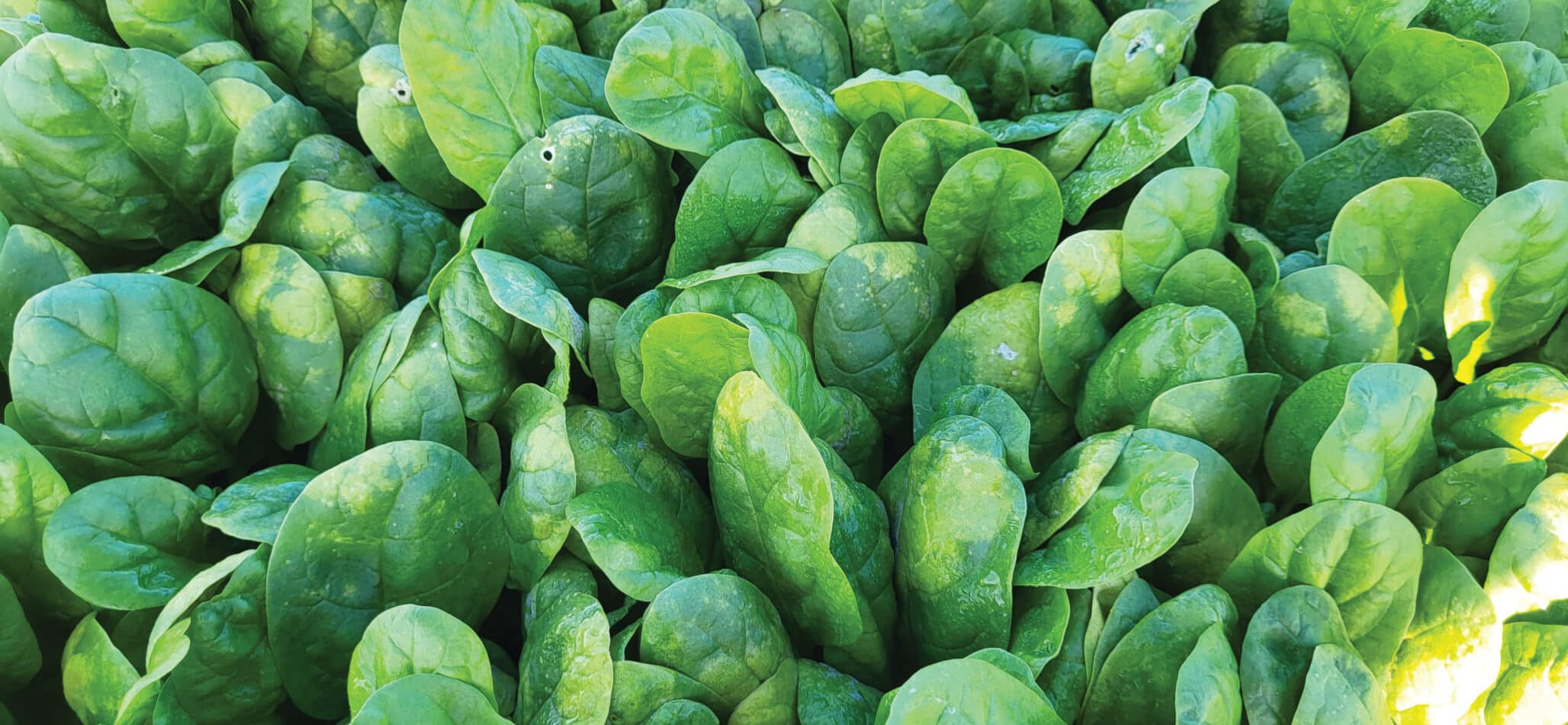In a new USDA study, researchers are working to find disease resistance at the molecular level.
University of Arkansas scientists are researching ways to increase disease resistance in a superfood that is growing in popularity in American diets.
Full of vitamins and minerals, spinach consumption has increased dramatically in the U.S. in recent years due to its inclusion in ready-made salad mixes available at grocery stores. However, it is also susceptible to a slew of diseases including Fusarium wilt, white rust and downy mildew. It also faces relatively new disease pressures from Anthracnose leaf spot and Stemphylium leaf spot.
“Downy mildew is a disease that affects spinach production worldwide,” says Ainong Shi, University of Arkansas associate professor. “Fusarium wilt is one of the most important diseases affecting seed production.”
Like most foods produced for human consumption, spinach production has very little room for error.
“The quality standards are very high for spinach production,” says Jim Correll, U of A distinguished professor at the Department of Entomology and Plant Pathology. “If disease damages as little as 3% to 4% of a field, it will make the entire crop unmarketable.”
With spinach costing around $5,000 an acre to plant, it can be economically devastating if growers have to terminate a field due to diseases. The largest spinach-producing states are California, Arizona and Texas. The majority of American spinach seed production occurs in the Pacific Northwest.
Shi is the lead researcher on a four-year, $3.57 million U.S. Department of Agriculture grant to help increase disease resistance in spinach. He will lead a group of multidisciplinary researchers from several states as they try to find molecular pathways within spinach’s genome that may help the plant fight diseases.
This grant will build upon and validate findings from Shi’s previous USDA-funded project that sought to develop ways for spinach to move from conventional breeding into molecular breeding. In that project, Shi screened cultivars for disease resistance, developed a genetic map for spinach and discovered genetic variations within spinach cultivars.
“In the first project, we found some genetic variations that we can use as bookmarks to look for areas within the spinach genome that might hold keys to disease resistance,” Shi said. “We still have a lot more bookmarks to develop and genetic processes to understand.”
The University of Arkansas is home to a world-renowned spinach breeding program. Researchers there have worked to develop new varieties for at least 50 years, and they are the only publicly-funded university conducting spinach variety development. Spinach utilizing University of Arkansas-developed breeding lines are incorporated into commercial seed production and found throughout the world.
Correll has been working on spinach breeding lines for at least 20 years, and he developed a line of spinach that is resistant to white rust. Shi has been working on spinach breeding for at least 10 years and was able to locate genetic markers for disease resistance in the line Correll developed.
The molecular breeding technology Shi developed allows him to scan large datasets within spinach’s genome to find potential locations that may play a part activating disease resistance.
“You can compare genomics to a dictionary that is not alphabetized,” says Correll, who is a co-primary investigator on the grant. “Shi’s technology helps us more easily find bookmarks for disease resistance within that unorganized genetic dictionary.”
In this new grant, Correll and U of A post-doctoral scholar Gehendra Bhattarai will screen 600 unique groups of seeds from four U.S. seed banks, commercial varieties and wild relatives for resistance to each of the five diseases. Since no two diseases are the same, scientists need to better understand how the plant’s genetic pathways respond to threats from each disease. Identifying these pathways will aid plant breeders in the development of new varieties.

“The molecular markers Shi has developed speed up the traditional breeding process and make it much more efficient than traditional breeding techniques,” Correll says. “A number of his markers are already in use, but this grant will help us add to our toolbox.”
Once Shi identifies a potential trait or genetic process that triggers disease resistance in spinach, collaborating researchers will breed cultivars containing that specific trait. Those larger populations will then go into a greenhouse experiment to determine their merit by observing their environmental and genomic responses to disease pressure. Those that show promise in the greenhouse will go on to field experiments. Those that do well in field experiments will be made available to plant breeders to develop new breeding lines.
Shi has already identified several locations on the spinach genome that may help plants with disease resistance, but more research is needed for scientists to better understand how spinach responds to disease pressure.
“It’s like trying to develop a dictionary,” Correll says. “We know a lot of words, but the dictionary is not completed yet.”
The overall goal of the project is to develop spinach cultivars that are more resistant to diseases. Researchers will develop molecular tools that they can use to move resistant traits between plants for new cultivar development. Once disease-resistance traits are found, seed companies will be able to use the markers the scientists develop in their breeding programs.
One of the goals of this project is to reduce growers’ dependence on pesticides. This is particularly important to organic producers who cannot use conventional fungicides on their crops.
“We hope the long-term goals of this project include the development of improved spinach cultivars and breeding lines, improved genetic tools for better breeding methods, and the development of new spinach varieties that have greater disease resistance and are suited to be grown in major U.S. spinach production areas,” Shi says.
While the disease markers they find in this study will be specific to the spinach genome, researchers believe Shi’s molecular breeding techniques could be used to find disease resistance traits in other vegetables that could be made into new, more disease resistant varieties.
The University of Arkansas scientists already have established relationships with spinach growers and trade associations. They will share their findings from this study during grower meetings.
Researchers from Texas A&M, USDA- Agricultural Research Station in Salinas, California, Washington State University, University of Arizona and University of Massachusetts are also contributing to the research project.










